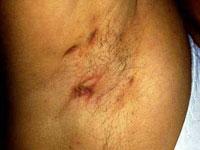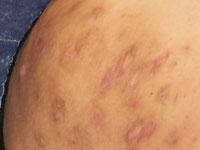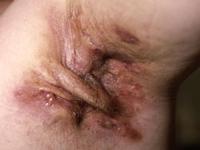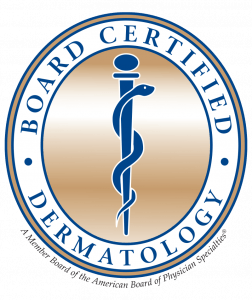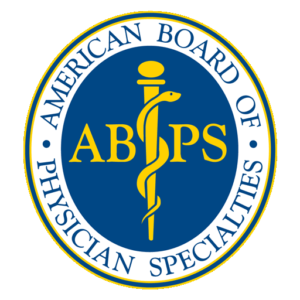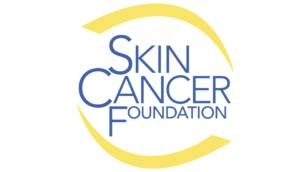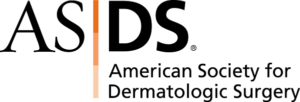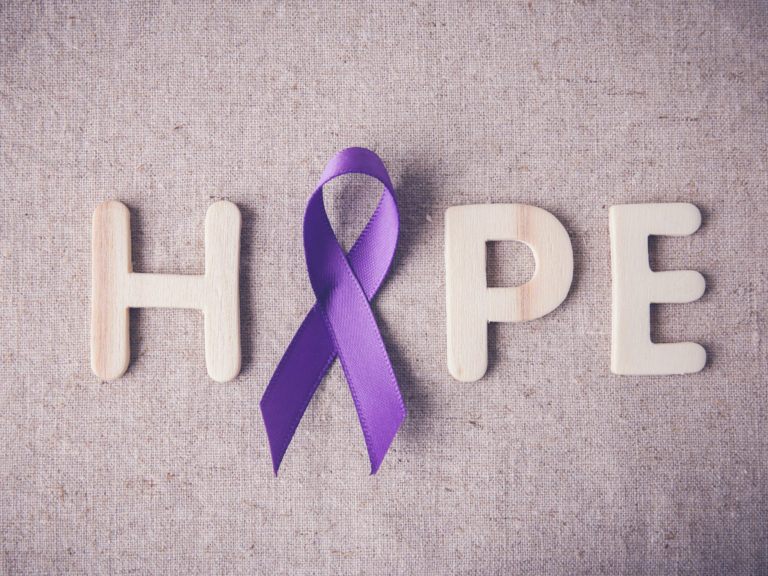
What Does Hidradenitis Suppurativa Look Like?
The images below are blurred to avoid showing potentially unwanted content. To view them un-blurred, simply hover your mouse cursor over them or tap if you are on a mobile device.
What is Hidradenitis Suppurativa?
Hidradenitis Suppurativa (HS) is an under recognized disease marked by chronic and recurrent boils (i.e. absesses localized to the axilla (i.e armpits), underneath the breasts, groin, inner thighs, pubic area, buttocks and perianal region. Although HS condition is not contagious, some patients become secondarily infected with Staphylococcus aureus bacteria. In its earliest stage, a patient with Hidradenintis Suppurativa may develop a solitary abscess with healing and then a month or two later will develop a new abscess. In other patients, the condition can become more persistent with chronic absesses developing into sinus tracts (i.e. tunnels underneath the skin). And rarely, the sinus tracts can become widespread with significant scarring.
Frequently Asked Questions
For all patients, it’s best to start with some lifestyle modifications that include the following:
- Weight loss
- Eliminate cigarettes
- Oral zinc 50 - 100 mg a day with food
- Benzoyl peroxide wash or chlorhexidine wash
- Clindamycin gel or solution to any active lesions
Intralesional cortisone injections ( triamcinilone ) for mild lesions or mild flares can be quite useful. Recent scientific data has supported this therapy.
For more frequent inflammatory lesions, patients will often start on an antibiotic regimen such as oral doxycycline or minocycline. It is important to know that antibiotics are not treating a bacterial infection but rather the inflammation associated with the condition.
For lesions that do not respond to the above antibiotics, a regimen of oral clindamycin with oral rifampin has been shown in studies to be effective in inducing remission of the disease. Diarrhea may be seen as a side effect of this treatment. And in addition, it is important to remember that rifampin can have interactions with other medications, for example, it can make birth control pills less effective.
Studies have shown that NdYAG 1064 and other hair removal lasers may be effective in controlling HS.
A recent study combining minocycline and colchicine has shown some promise.
Oral spironolactone (an androgen blocking agent ) in women can be helpful.
Oral dapsone may be helpful.
In men, it may be reasonable to try finasteride 5 mg a day.
Humira 40 mg weekly has been FDA approved for the treatment of HS. On average, 50% of people get 50% improvement.
Deroofing of sinus tracts and wide surgical excision are other options.
The emotional effects of HS can be devastating. For people suffering with this condition, a local support group in Detroit is available through Henry Ford hospital.
Please visit Hope for HS There is hope, you are not alone!

